10 THINGS YOUR HORSE WOULD BE HAPPY IF YOU KNEW
There are LOTS of things our horses sense when we’re riding we should know about. Hundreds. Thousands even! But If you knew just these 10 things, your horse would be happier under saddle.
FACTS: A successful Horse / Human Connection depends on each party feeling comfortable, safe, and understood. Building communication and mutual understanding are only possible when those elements come together.
The nature of horses includes SAFETY as a priority rooted in all elements of their physical, mental and emotional beings. Without feeling comfortable, feeling safe is not possible. Without their riders’ understanding of their perception of physical, emotional and environmental conditions, horses are likely not feeling safe nor comfortable. Certainly not in a “happy” state.
Let’s look at saddle fit as a good example of where people often get it wrong.
Horses need to be free from pain when being ridden. It’s our job to ensure this is the case. After all, we’re the ones choosing to enjoy the privilege of riding upon their backs (not to mention putting our lives in their hooves).
Over the course of 20 years pursuing perfection in saddle making and fitting, we’ve seen interesting proof of what can happen when a horse is suffering under its saddle.
Obvious signs include spookiness, rushing, refusal to move, bucking, tail swishing, head tossing, etc.
These (and more subtle signals) show ways in which horses communicate their displeasure.
Of course, they’re not “thinking about being understood”! They’re reacting to their environment, bracing in their mind and bodies and it could even get really “fire-breathing dragon” ugly It’s our job to do the understanding if we care to fix it for the sake of the horse…and perhaps to save our own lives.
Here are 10 things your horse wishes you knew when it comes to Saddle Fit.
Some you may know. Some you may not.
Perhaps use it as a checklist to be sure.
This can ensure your equipment will FIT YOUR HORSE’S BODY when it’s IN MOTION. Mental, emotional, and physical damage can result if you don’t safeguard this.
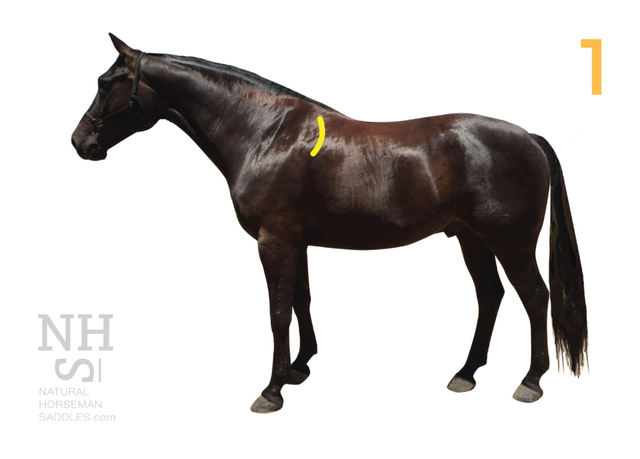
Locate your horse’s shoulder blade’s back edge
While your horse is standing squarely, feel gently but firmly with your fingertips to find the back edge of the shoulder blade (scapula). You’ll feel where the firm muscular area drops off. Make note of that location for saddle position.
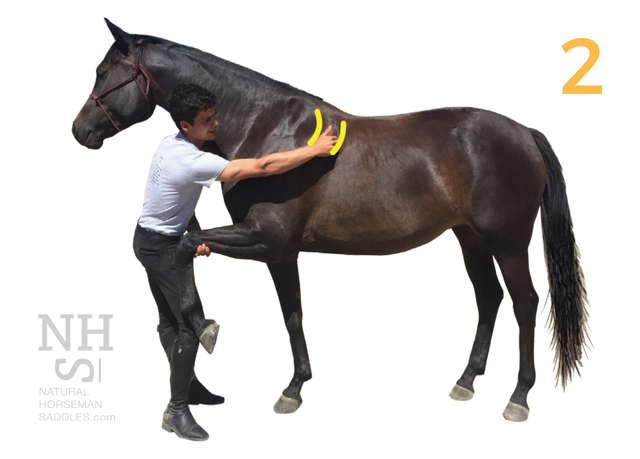
Determine how far it swings back
Lift the front knee and pull it forward while feeling with your other hand as the shoulder muscles pull the scapula backward. This is what happens in full stride. Feel firmly to be sure you locate the furthermost point of the backswing and muscle bulge.
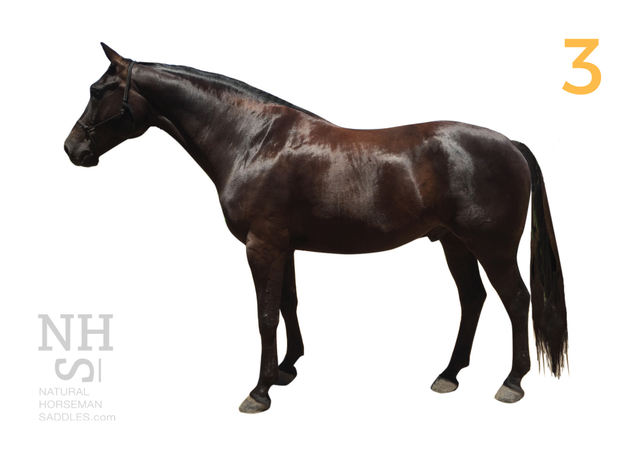
Observe the natural downward curve of the center back area of your horse’s topline profile at a standstill
When your Horse is standing still (with head up) you can see the natural slope of the back. From the moment the first step is taken, your horse’s body will become a totally new set of shapes that need to be accommodated by your saddle.
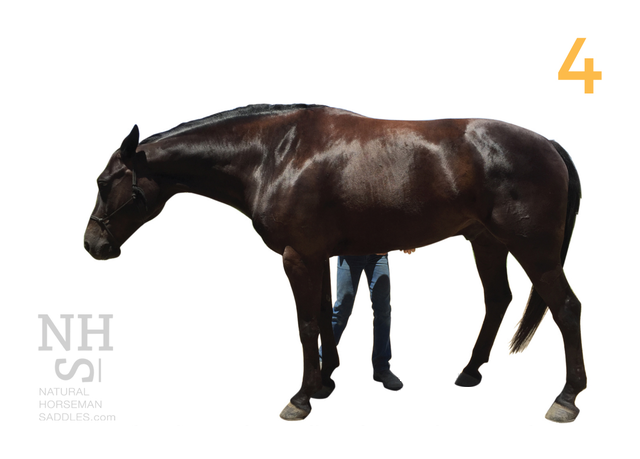
Observe the change in top line shape when your horse engages abdominal muscles and lifts back
By “tickling” your Horse firmly in the groove of the under-abdomen midline, he will be stimulated to show you the natural lifting potential of his back. You can then visualize how much room your saddle will need to remain unrestrictive. Saddles with our Smartflx saddle foundation are built to accommodate this.
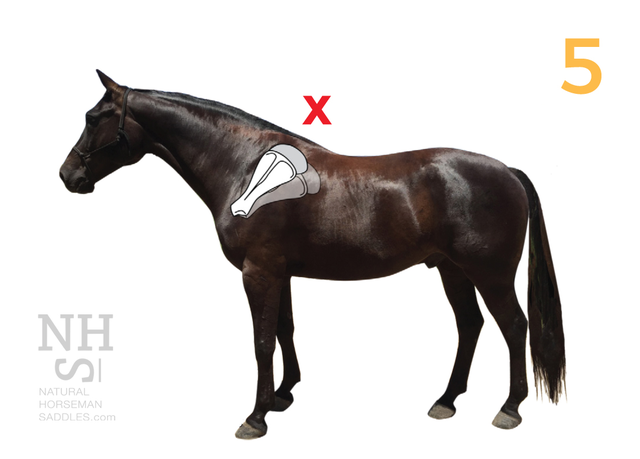
BE AWARE: you must keep excessive pressure off this area
Your horse’s shoulder blade (scapula) is a large paddle-shaped bone connected to his upper leg bone.
Powerful muscles engage to pull it backward in full stride. If these muscles are impeded by saddle/rider pressure,
it changes how a horse’s entire body travels and can result in damage. Saddles made to fit the horse’s shoulder shape
when standing still cause pain when he tries to travel naturally! Once you have located the back edge of your horse’s
shoulder blade at standstill AND at its maximum backswing point, you can visualize how much room the shoulder needs to
operate underneath the front of your saddle. We’ll show you how to protect this area in #9 & #10
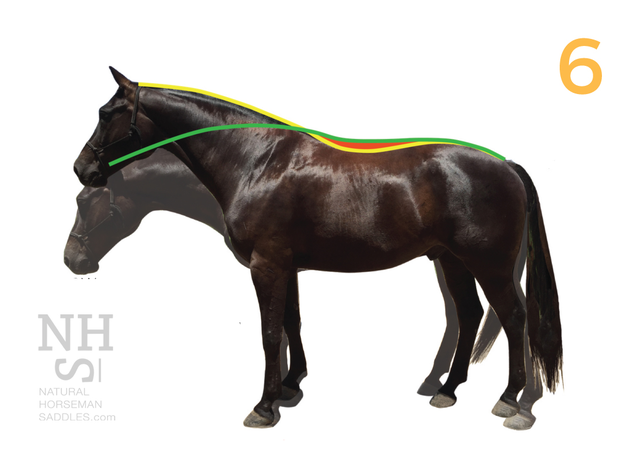
BE AWARE: your horse needs room to lift his back
Once you know how much your horse lifts and expands his back in motion, you know how much room your saddle needs to provide
underneath in order to avoid compromising natural movement and causing pain. Saddles made with a downward curve that fits the
horse’s body at a standstill cause pain when the horse tries to move efficiently!
IS YOUR HORSE’S BODY LARGER OR SMALLER THAN YOUR SADDLE?
Unfortunately, most saddles are not built in a shape that will welcome the horse’s body when it is moving.
Once you know whether the underside of your saddle is large enough to fit your horse’s back as it lifts and
expands, you can plan accordingly. If your saddle is smaller than your horse even before he starts to move, you
can be sure it will pinch him from the moment he takes his first step… unless you do something about it.
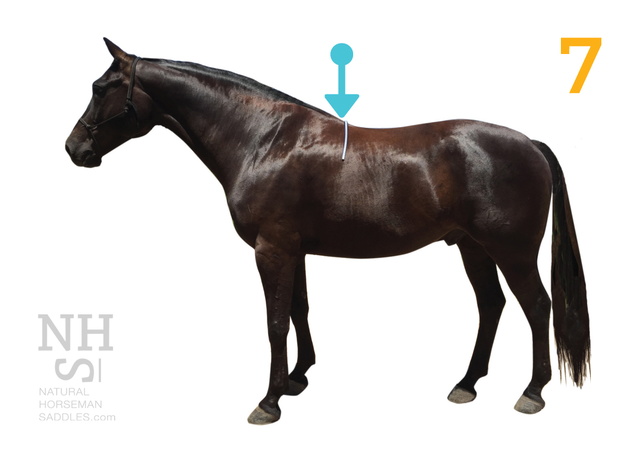
Measure this area on your horse
Gently press/mold a FLEXI-Curve (pliable ruler) over your horse’s spine in the area about 2″ // 5 cm behind
the shoulder blade’s back edge. NOTE: IT IS BEST TO TAKE THIS MEASUREMENT AFTER YOU HAVE EXERCISED YOUR HORSE ONLINE for at least 5 minutes.
That way, you will know how much the muscles in the region are capable of bulging….and how that compares to the underside dimension of your saddle.
If the muscle is depleted in this area, don’t worry…it can re-develop with your understanding and help.
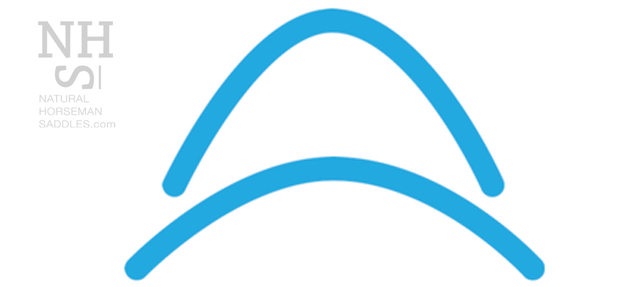
Is your Horse’s body larger or smaller than your saddle?
COMPARE the 2 Flexicurve arcs. Is your horse’s dimensions larger than the saddle?
OUCH!
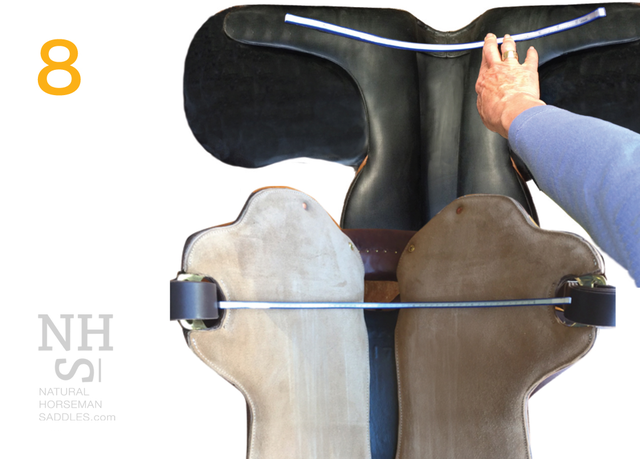
Measure your saddle
Gently press/mold a FLEXI-Curve underneath your saddle in the region that will be occupied by your horse’s body area behind the shoulder blade.
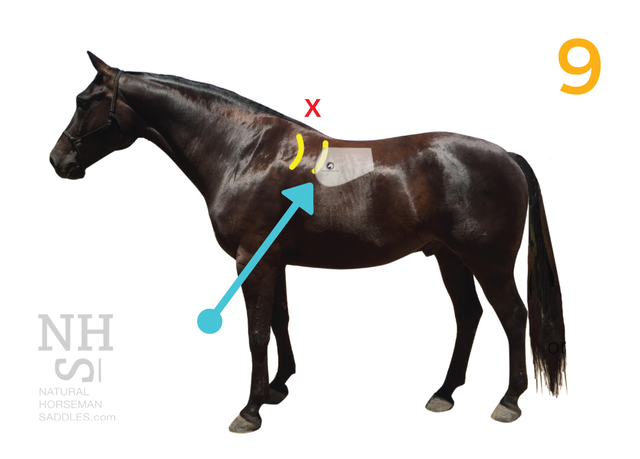
Use a SHIM behind the X to protect this area by providing space underneath the front of your saddle for your horse’s muscles to bulge and flex without restriction.
Does it seem amazing that the use of a TAPERED FOAM SHIM in this position (note tip of the blue arrow showing the front edge of a tapered foam shim) could make a big difference in the
efficiency of your horse’s biomechanics? We encourage you to try it. Your Horse will thank you!
BEST WAY to keep excessive pressure off the X zone:
Tuck a TAPERED FOAM SHIM (of the right density/resilience) inside pad shim pocket or on top of your saddle pad) at the furthermost backswing point of your horse’s scapula.
The thick front part of the shim will lift saddle pressure off the bulging working shoulder. The thin tapered part (toward the rear of the shim) will transition gradually along your Horse’s
body comfortably to improve dynamic custom fit dramatically. Muscles damaged by previous saddle systems can re-develop nicely!
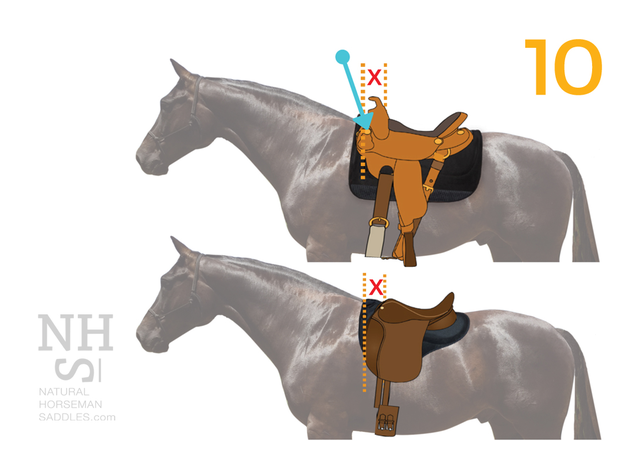
Place your saddle in the right location & keep excessive pressure off the X zone!
Position your WESTERN SADDLE so the FRONT CONCHO is located over the back edge of your horse’s shoulder blade while he is
standing to be saddled.
After you tighten your cinch or girth, take time to feel under the front of your Western OR English saddle AND pad to determine if the
shoulder range of motion would be compromised because it is too tight there. When your horse is ready to ride, you should be able to reach all the way back under the pad & saddle to the stirrup bar area without your fingers being pinched too uncomfortably.
Cinch or Girth should be a hand’s breadth behind the armpit (not jammed up against the elbow).
Position your ENGLISH SADDLE so the FRONT EDGE of the saddle’s under-flap is located behind the back edge of your horse’s scapula (up to 2 finger-widths behind it!) while he is standing to
be saddled.
If your saddle is a forward-flap Jump style, feel for the tree’s points and position them behind the shoulder blade’s back edge.
If you are concerned about special fitting or shimming needs for your horse, please CONTACT
[email protected] to request your
FREE SADDLE
FIT EVALUATION
